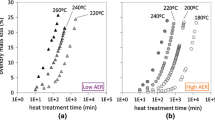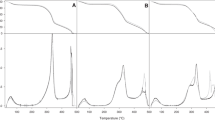Abstract
The aim of this study was to determine the changes in formaldehyde emissions of eucalyptus particleboards produced from logs stored under different conditions (indoor, outdoor, and under water) or steamed. The pH and Stiasny values of particles changed significantly according to the storage condition and log steaming process. The pH values of particles obtained from steamed logs and stored outdoors for 4 months were found to be lower than those of the particles obtained from logs stored in the other aforementioned two conditions. The peaks of acetyl groups in the IR-spectra of the four group particles were similar. There was a strong relationship among the formaldehyde emission values of the panels pressed at 150 °C and the Stiasny values of the particles from which the panels were produced. The formaldehyde emission values of the panels pressed at 190 °C were lower than those of the panels pressed at 150 °C.
Zusammenfassung
Ziel dieser Untersuchung war es, Änderungen in der Formaldehydabgabe von Eukalyptusspanplatten zu bestimmen, die aus unterschiedlich gelagerten (Innen-, Freiluft- und Wasserlagerung) sowie gedämpften Stammabschnitten hergestellt worden waren. Der pH-Wert sowie die Stiasny-Zahl der Späne unterschieden sich je nach Lagerungsart und Dämpfung der Stammabschnitte signifikant. Die pH-Werte von Spänen, die aus gedämpften oder über einen Zeitraum von vier Monaten im Freien gelagerten Stammabschnitten hergestellt worden waren, lagen niedriger als diejenigen von Spänen aus innen- bzw. wassergelagerten Stammabschnitten. Die Peaks der Acetylgruppen in den IR-Spektren waren bei allen vier Gruppen ähnlich. Es bestand ein großer Zusammenhang zwischen den Formaldehydabgabewerten der bei 150 °C gepressten Platten und den Stiasny-Zahlen der Späne, aus denen die Platten hergestellt worden waren. Die Formaldehydabgabe der bei 190 °C gepressten Platten war niedriger als diejenige der bei 150 °C gepressten Platten.
Similar content being viewed by others
References
Aucoin JP (1997) Variation in wood pH and its impact on resin cure in oriented strand board (OSB). M.Sc. Thesis, Forestry Graduate Department of Forestry, University of Toronto
Choon KK, Roffael E (1990) The acidity of five hardwood species. Holzforschung 44:53–58
Çolak S, Çolako~glu G (2004) Volatile acetic acid and formaldehyde emission from plywood treated with boron compound. Build Environ 39:533–536
Çolak S, Çolako~glu G (2006) Effects of wood species and adhesive types on the amount of volatile acetic acid of plywood by using desiccator-method. Holz Roh- Werkst 64:513–514
Çolako~glu G, Çolak S, Tüfekçi M (1998) Einfluss der Dämpfung und Trocknung von Furnieren auf deren Acetylgruppengehalt und die Formaldehydabgabe von Sperrholz. Holz Roh- Werkst 56:121–123
EN 717-3 (1996) Wood Based Panels – Determination of formaldehyde release – Part 3: Formaldehyde release by flask method, European Committee for Standardization, Brussels
Green DW, Evans JW (2001) Flexural Properties of Structural Lumber Products After Long-Term Exposure to 150°F and 75% Relative Humidity. Proceedings of the 35th International Particleboard/Composite Materials Symposium, Washington State University, WA
Hanetho PL (1987) Jahresbedingtes Qualitätsproblem bei Spanplatten durch Rohholzeinsatz. Vortrag der FESYP, 10/11. März 1987, München pp 129–136
Kehr E, Wehle HD (1988) Untersuchungen über den Einfluss verschiedener Holzarten auf die Formaldehydabgabe von Spanplatten. Holztechnologie 29(6):285–289
Lelis R, Roffael E, Becker G (1993) Zum Verhalten von Splint- und Kernholz der Kiefer bei der Verleimung mit UF-Harzen. Holz-Zentbl 7:120–121
Lelis R, Roffael E, Becker G (1994) Zur Verleimbarkeit von Splint- und Kernholz von Douglasienholz mit PF-Harzen. MUPF-Harzen und Diisocyanat-Klebstoffe (PMDI). Holz-Zentbl 120:131–132
Lelis R, Roffael E (1995) Über die Reaktivität von Douglasiensplint- und -kernholz und deren Heisswasserextrakte gegenüber Formaldehyd. Holz Roh- Werkst 53:12–16
Marutzky R (1986) Einfluss der Lagerung auf die Verwertbarkeit von Nadelholz als Rohmaterial für Zement gebundene Holzspanplatten, Teil 2, Ergebnisse der Lagerungsversuche. Holz-Zentbl 113:1570–1572
Marutzky R (1999) Braucht man für Span- und Faserplatten noch Wald? Holz-Zentbl 125(142):34
Nemli G (2002) Factors affecting the production of E1 type particleboard. Turkish J Agric For 26:31–36
Packman DF (1960) The acidity of wood. Holzforschung 14:178–183
Panamgama LA (2006) Polyphenolic extracts of pinus radiata bark and networking mechanism of additive accelerated polycondensates. J Appl Polym Sci 103(4):2487–2493
Roffael E (1982) Die Formaldehydabgabe von Spanplatten und anderen Werkstoffen. DRW-Verlag, Stuttgart
Sachsse H, Roffael E (1993) Untersuchung der Schälfurnier-Eignung von in Deutschland erwachsenem Douglasienholz. Holz Roh- Werkst 51:167–176
Sekino N, Inoue M, Irle M, Adcock T (1999) The mechanisms behind the improved dimensional stability of particleboards made from steam-pretreated particles. Holzforschung 53:435–440
TAPPI t m-45 (1992) TAPPI Test Methods 1992–1993, TAPPI Press Atlanta, Georgia
Author information
Authors and Affiliations
Corresponding author
Rights and permissions
About this article
Cite this article
Çolak, S., Colakoglu, G., Kalaycioglu, H. et al. Effects of log storage conditions and steaming process on the formaldehyde emissions of particleboard manufactured from eucalyptus (E. camaldulensis) wood . Eur. J. Wood Prod. 67, 379–382 (2009). https://doi.org/10.1007/s00107-009-0331-3
Received:
Published:
Issue Date:
DOI: https://doi.org/10.1007/s00107-009-0331-3




